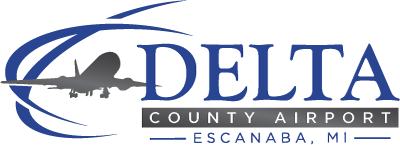Delta County Airport is a county-owned public-use airport located two nautical miles southwest of the central business district of Escanaba, MI. The Airport offers commercial air service to Detroit, MI twice daily and is included in the Federal Aviation Administration (FAA) National Plan of Integrated Airport Systems as a non-hub primary commercial service facility.
Delta County has humble beginnings for such an impactful airport. Harry Cowling made the first airplane flight in Escanaba on July 3, 1911, flying a Curtis bi-plane. The flight was very short as Mr. Cowling landed into a pine tree. Between 1911 and 1925 several barnstorming aviators including Baxter Adams, Wally Rowell, and Ernie Berg flew into Escanaba for aerial demonstrations and to offer rides to passengers.
Escanaba was the first Upper Peninsula (U.P.) town to establish a landing field and flying school, after former U.S. Army Air Cadet Walter “Wally” Arntzen offered flying lessons and pleasure rides as early as 1925. He built a small private hangar near the bay shore, but the exact location remains unclear.
The first Escanaba airport was dedicated September 20, 1928. The field was built by Upper Peninsula Airways, was constructed on 73 acres of land near the junction of U.S. 2-41 and Groos Road (County Road 426). The original hangar buildings still exist.. The owner engaged Walter Arntzen as chief pilot and instructor. The airport remained at this location until the mid 1930’s.
On December 19, 1933 the City of Escanaba purchased two separate parcels of property for the intent to develop a new airport (the current airport property). Hangar construction projects commenced in 1936 as part of the Work Projects Administration Program of the mid-1930’s and was considered instrumental in the development and expansion of several airport hangars and landing fields in the Michigan’s U.P.
One of the first buildings, and the original airport terminal, was constructed by Pioneer Aviation, who operated a flight school along with a small airline.
In August 1969 Escanaba Municipal Airport constructed what is currently the Airport Terminal to the South of the first airport terminal. The new facility was built to better accommodate the use of Convair aircraft along with the future anticipation of jet aircraft (Northcentral Airlines began DC-9 service soon after).
Escanaba operated the municipal airport until 1973 when the city turned over the ownership of the facility to the County of Delta. The County opted to not change the name from Delta County Airport.
Post 1978 Airline Deregulation Delta County Airport becomes an Essential Air Service airport.
What Heroes are Made of...
January 24, 1953 – Despikte a 28 mile-per-hour howling wind, two pilots made six landings on a three inch thick ice flow to rescue six Escanaba fisherman.
The men were putting out smelt nets on the bay a mile from shore when a section of the ice broke off and began moving toward the lake.
Pilots Jon Thorin and Wilbert “Red” DeGrave, both from Escanaba, took off in their Piper Cubs and made three landings each on the floe to rescue the fishermen, ferrying the fishermen back to land. The operation took two hours.
Jon and Red received significant publicity for the tremendous feat, along with a “Carnegie Medal for Heroism”. Both are honored on the Airport’s Wall of Fame inside the Terminal.
Homegrown Hero
Wally Arntzen was an Army Air Cadet who returned after his training to Escanaba in 1925 to become the first local aircraft owner. He started a flight school and barnstormed around the peninsula in his OX-5 “Jenny”, thrilling U.P. residents with loops and tail spins.
Wally’s father was the first architect in the State to utilize an airplane on field supervision trips to building job sites, using his son as his own personal pilot.
Arntzen made several mercy flights which saved the lives of lost hunters, marooned fishermen, and persons in need of immediate surgery. He taught more than 100 students how to fly. Arntzen was also active with the Army’s Air Transport Command in WWII, flying thousands of hours and countless miles to deliver B-17 Flying Fortresses.
Republic F-84F Thunderstreak Monument
The aircraft on display was flown down from Massachusetts, demilitarized by a crew from K.I. Sawyer, then placed on top of the mount where she sits today.
The F-84F was primarily a U.S. Air Force’s primary strike aircraft during the Korean War, flying 86,408 sorties and destroying 60% of all ground targets in the war as well as eight Soviet-built MiG fighters.
The aircraft remains property of the U.S. Air Force and is on loan from Wright Patterson Air Force Base in Ohio.
